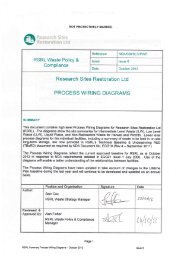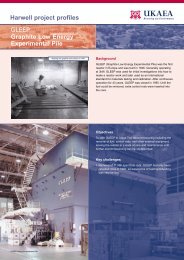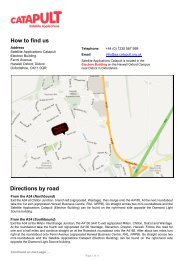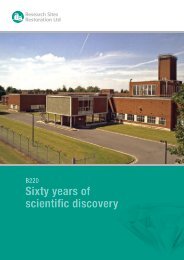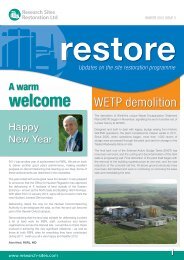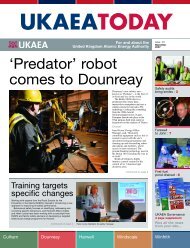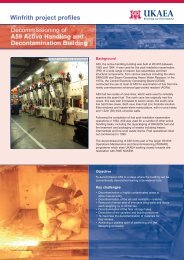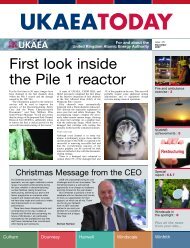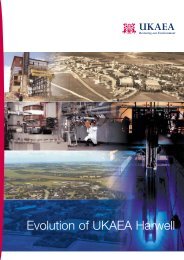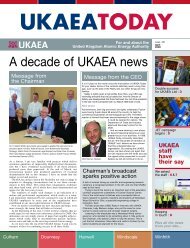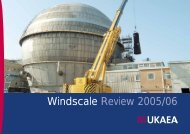RSRL Integrated Waste Strategy - Issue 5- Oct 2012.pdf
RSRL Integrated Waste Strategy - Issue 5- Oct 2012.pdf
RSRL Integrated Waste Strategy - Issue 5- Oct 2012.pdf
Create successful ePaper yourself
Turn your PDF publications into a flip-book with our unique Google optimized e-Paper software.
NOT PROTECTIVELY MARKED7.1.3 Low Level <strong>Waste</strong>308. <strong>RSRL</strong> is developing alternative routes for LLW in accordance with the actions listed inthe Joint <strong>Waste</strong> Management Plan. Of particular interest are off-site treatment routes forsegregated metals and combustible materials. <strong>RSRL</strong> is currently exploring the option ofsmelting metallic LLW and have identified some drums of suitable waste at Winfrith forwhich LLWR have quoted for treatment overseas. Transfer of this waste via the LLWRframework supplier contract is due to take place by the end of 2012. A route for disposal ofVLLW and LA-LLW at an off-site landfill have been in place for Harwell waste since March2012 and <strong>RSRL</strong> is working to establish this route for Winfrith wastes as well.309. In the site waste BPEO study the solid LLW was broken down into four categories: solidnon-combustible LLW, solid combustible LLW, solid VLLW and HV-VLLW wastes. Althoughthe current strategy is to send both combustible and non-combustible LLW to the LLWR,these wastes were differentiated in the study as it was envisage that there would bealternative options available in the future.310. <strong>RSRL</strong> has recently undertaken high-level strategic BAT reviews for metallic LLW,Winfrith LA-LLW / VLLW and “soft-solid” LLW (formerly this was referred to as “combustibleLLW” however as there are a number of treatment options available for this type ofsecondary waste the term “combustible” LLW is no longer appropriate). These reviewsincluded reassessment of the underlying assumptions and decisions taken at the time of theoriginal BPEO studies. A representative from LLWR Ltd attended each of the reviews.7.1.3.1 SGHWR Sludges311. SGHWR sludges are a mixture of organic resins used for the treatment of the reactorprimary coolant and sludge from primary circuit decontamination. Both bulk sludges andtank heels have been processed by encapsulation in cement inside 500-litre drums in theWETP. A sandy residue has been grouted into 40 litre grouted cans for disposal to theLLWR.312. These sludges are LLW but due to LLWR restrictions on the conditions for acceptance ofsome radionuclides they have in the past been managed as ILW. Following re-negotiationof LLWR’s position on the SGHWR sludges, <strong>RSRL</strong> has changed its baseline strategy forthese wastes to be disposal to the Low Level <strong>Waste</strong> Repository rather than the GDF. <strong>RSRL</strong>is working closely with LLWR to gain formal acceptance of the sludges however this isunlikely to be obtained until such time as LLWR have received an updated EnvironmentalPermit which aligns with their current Environmental Safety Case and it is possible for LLWRto assess the impact of the SGHWR sludges on their ability to receive waste from othercustomers.7.1.3.2 Solid Non-Combustible LLW313. Solid low level radioactive waste (LLW) is generated on the Winfrith site from routineoperations, the decommissioning of redundant nuclear facilities and the removal ofcontaminated land. The volumes involved vary depending on the type of operationundertaken and include change-room waste associated with the routine access/egress toactive areas, secondary wastes unavoidably generated during operations and materials thatbecome waste at the end of their useful life. The wastes will be in the form of wasteresidues, extract filters, scrap equipment and redundant plant.314. In developing its LLW management strategy Winfrith takes cognisance of the IndustryCode of Practice on Clearance and Exemption and where possible, segregates and<strong>RSRL</strong> IWS (<strong>Issue</strong> 5 – <strong>Oct</strong>ober 2012)86




